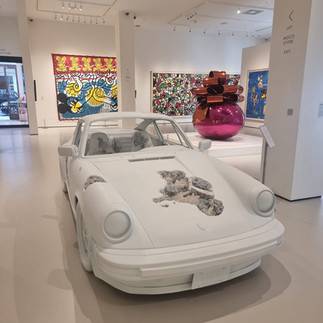Time, Texture, and Timeless Machines: Daniel Arsham at Moco Museum
- Radhika Patel
- Apr 12
- 3 min read
Daniel Arsham is one of those few artists who doesn’t just work across disciplines — he dissolves the lines between them. A self-described “fictional archaeologist,” he operates at the intersection of art, architecture, performance, fashion, and design.

His sculptures have been described to be like relics from the future, decayed but preserved, casting contemporary objects — like Game Boys, phones, cars — in materials like selenite, volcanic ash, and crystal. These eroded forms suggest a future where our current culture has fossilised, but not disappeared. His work makes you think: what will survive us?
Arsham draws inspiration from architecture, cinema, history, and pop culture, and collaborates with creative icons like Pharrell, Usher, Merce Cunningham, and Ronnie Fieg of KITH. Whether designing a retail space or recreating a Ferrari 250 GT as a crystalline ruin, his work doesn’t just look good — it tells stories. Stories about the impermanence of icons, and the beauty that still exists when time leaves its mark. His art challenges the idea that aging means erasure. Instead, it becomes a layer — adding depth, narrative, and meaning.
I had the chance to see one of Daniel Arsham’s standout pieces in person at the Moco Museum in London: the Blue Calcite Eroded Porsche 911. The classic 1980 911 silhouette is instantly recognisable — timeless, but here, it had been reimagined in a state of elegant decay. Parts of the car were missing, replaced with shimmering blue calcite and quartz, as if nature had begun to reclaim machine. It felt like an artefact excavated from a distant future — where design becomes geology, and function gives way to symbolism.
What struck me most was seeing it in a museum, rather than a showroom or racetrack. Was a slight shift mentally. It wasn’t about horsepower, legacy, emotion or performance — it was about symbolism & a deeper memory. It felt like a physical embodiment of the question: What do we leave behind, and how does time transform it? This wasn’t just a car. It was culture. That really got me thinking. As someone who’s spent decades working across art, motorsport, luxury, design, fashion and wellness, I’ve always felt drawn to the spaces where disciplines blur. In my own creative journey, I’ve explored similar contrasts — blending the raw, technical precision of automotive forms with the delicate, ethereal beauty of crystals and nature. Like Arsham, I’m fascinated by the collision of opposites: masculine and delicate, speed and stillness, old and new. His work is a reminder that objects don’t lose meaning as they age — they gain it.
The deeper you dive into his process, the more layers unfold. Take his recreation of cinema cars, for example. The DeLorean from Back to the Future — a futuristic failure that somehow aged into a nostalgic icon — was sourced and cast with intricate precision. The Ferrari 250 GT from Ferris Bueller’s Day Off? He didn’t just sculpt a version of it — he tracked down the original prop designer from the film and had them recreate the exact replica used on screen. (The driving scenes didn’t feature real Ferraris — only the one parked in the garage was genuine.) He chose this model partly because only 55 were ever made, adding to its rarity. It’s this kind of obsessive storytelling that gives his work such depth.
Even his limitations have become a kind of creative lens. Arsham is colourblind, so he often works in a muted, restricted palette. But rather than dulling the impact, it enhances it. The absence of colour becomes a statement — drawing attention to form, texture, erosion, and materiality. And then there’s his openness to collaboration. Fashion, music, stage design, architecture, film — he’s not just dabbling, he’s building worlds. His work doesn’t speak to a niche — it resonates across culture. He’s helped brands and creatives better understand what their identity feels like before defining how it looks. His audience isn’t a demographic — it’s anyone willing to slow down and see familiar things with new eyes.
For me, his work affirmed something I’ve always believed: creativity doesn’t live in one lane — it thrives in the intersections. I’ve been lucky to create across fashion, motorsport, art, wellness, and beauty, and it’s in those overlaps that I’ve found the most energy and innovation. Arsham’s work is a reminder that we don’t need to fit neatly into a box. Some of the most powerful ideas come from being open to exploring.








Comments